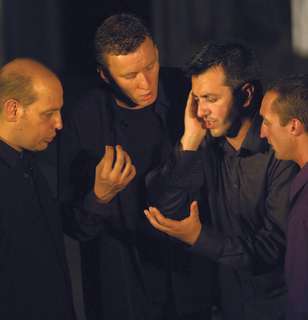|
Back
From the Corsican soil Toronto
Trinty-St. Paul's Centre
04/01/2011 - & 2 April*, 2011
Canti di a Terra (Traditional Corsican Songs)
Barbara Furtuna (a capella quartet), Constantinople (instrumental trio) 
Barbara Furtuna (Courtesy of The Toronto Consort)
Each season the Toronto Consort presents a visiting group at one of its sets of concerts. This year we were treated to a joint concert by Barbara Furtuna, a Corsican a capella quartet, with Constantinople, a Montreal-based trio that explores music of the eastern Mediterranean and places beyond.
The Toronto Consort, by the way, was founded back in 1972 by the ever-genial David Fallis who also frequently conducts productions of Opera Atelier (such as their upcoming La Clemenza di Tito). The venue was the Trinity-St. Paul’s Centre, a functioning church (United Church of Canada) that hosts many performances each year (it is also the main venue for the Tafelmusik Baroque Orchestra). It seats 770 but feels smaller thanks to the wraparound balcony.
Barbara Furtuna sounds like a woman’s name, but in Corsican (part of the Italian language group) it means “Cruel Fate”, which is also the title of one of the group’s songs. It could well be the title of most of them; as David Fallis stated in his introductory remarks, “Every Corsican lovesong ends badly.” We were soon to find this out.
Constantinople’s members consist of two players originally from Iran: Kiya Tabassian, who plays the setar (a plucked instrument that looks like a tiny theorbo) and who also sings, and Ziya Tabassian, a subtly prodigious percussionist. The third member is Pierre-Yves Martel, who plays the viola da gamba (of two different sizes in this concert).
Instrumental and vocal pieces were interwoven throughout the program. Last-minute changes to the order of pieces were announced, but the program deviated even further. Adding to this challenge was the fact that there were no translations of the supplied texts. Still the general meaning of each piece was clear.
After an instrumental opener, A moresca (an atmospheric Corsican piece from the 13th century), Barbara Furtuna sang Maria le sette spade a traditional song in Corsican (arranged by ensemble member Maxime Merlandi) focusing on Mary’s grief at the death of her son. It is suitably melancholy, with a processional quality when the instruments join the a capella voices.
Two Latin songs followed. The first, an Agnus Dei for all four vocalists, gave full display to the quartet’s intense performance style. Two of the members sculpt the sound with hand gestures while all four performers are intensely riveted on one another. This was followed by a song in praise of Mary, Tota pulchra es, Maria, for just two singers. Unlike the Agnus Dei, this was performed in a more elevated, detached (churchly) style; the first piece featured pulsating voices giving an earthy impression. This second piece ended with a beautifully sustained pianissimo.
Two 14th century Italian instrumental pieces followed, flanking another traditional song, Lamentu di Ghjuvan Camellu. As its title indicates, it laments a tragic love affair involving both disgrace and dishonour. The instrumental pieces were both from a Codex (29987) in the British Library, Lamento di Tristan (for the small gamba) and La Rotta della Manfredina.
This was followed by another traditional song, Ad Amore, sung by the group’s tenor (or terza), Jean Pierre Marchetti. It has a yearning sound - and the final line sums it up: “La mia speranza è morta”. One can certainly hear an influence leading to the heartfelt Italian pop song of today.
This was followed by Folias based on variations by Marin Marais for gamba and discreet accompaniment.
Anghjulina is a 12-stanza song (mournful again) for the four singers plus percussion. Songs like this can get repetitive, but this is full of vocal variation; it’s mostly for a solo singer with the others vocalising.
Then two more traditional songs: Lettera a Mamma is full of tristezza and amarezza – very anguished at its finale. Lamentu di Cursichella is a lament for Corsica and how it has been abandoned by so many of its sons. These were paired with pieces from the Persian world: Shourafkan, and Rouz o shab from a poem by the 14th century poet Hafez.
The final songs: Violetta (a capella – very intense) – another unhappy romance. This was followed by another religious piece (in Corsican) Diu vi Salve Regina, for all seven performers.
There were two encores, one a playful vocalise that spins out melismas to an exaggerated extent, then a more popular-sounding piece for guitar and setar, joined by the four vocalists.
It turns out that Corsican polyphony is quite the flourishing movement. Barbara Furtuna (see their website), in the midst of a multi-country tour, are by no means the only practitioners. The chemistry between them and Constantinople seemed ideal. The program’s title (“Songs from the land”) was certainly appropriate, demonstrating links between earthy, throbbing folk singing and religious expression. There seems to be nothing too abstruse for the early music audience which seemed to be more than pleased with this insight into a sound world new to most of us.
Michael Johnson
|